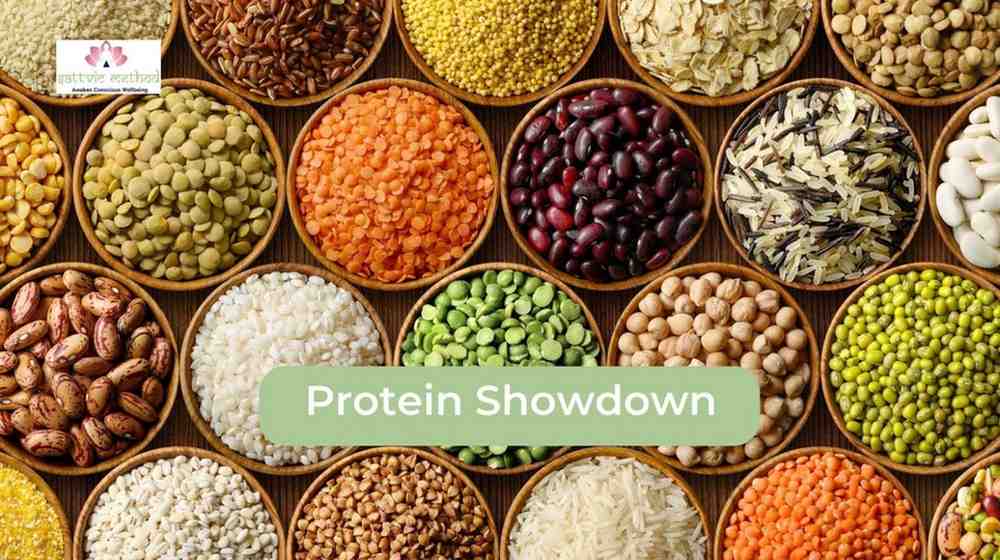In the battle of the legumes, two contenders step into the ring: Black Beans and Pinto Beans. These versatile and delicious legumes are not only popular in various cuisines but also pack a nutritional punch. But which one reigns supreme when it comes to protein?
Black beans and pinto beans are both excellent sources of plant-based protein, making them ideal for vegans, vegetarians, and those looking to incorporate more protein into their diets. However, they differ in taste, texture, and nutrient content.
In this article, we delve into the protein showdown between black beans and pinto beans. We compare the protein content, amino acid profile, and additional health benefits of these legumes. Whether you’re searching for a meatless protein option or simply curious about the nutritional value of these legumes, we’ve got you covered.
So, get ready to dig deeper into the world of legumes as we uncover which legume ultimately packs a punch when it comes to protein: Black Beans or Pinto Beans?
Nutritional Comparison of Black Beans and Pinto Beans
When it comes to the protein showdown between black beans and pinto beans, it’s important to understand the nutritional profiles of these two legumes. Both black beans and pinto beans are excellent sources of plant-based protein, but the specific nutrient content can vary.
Black beans are often hailed as the more nutrient-dense option, boasting a higher concentration of several essential vitamins and minerals. One cup of cooked black beans contains approximately 15 grams of protein, along with significant amounts of fiber, folate, iron, and magnesium. In comparison, a cup of cooked pinto beans provides around 14.5 grams of protein, with slightly lower levels of some nutrients like iron and folate.
However, it’s important to note that the specific nutrient content can vary based on factors such as the growing conditions, processing methods, and even the individual variety of the beans. Additionally, both black beans and pinto beans are considered excellent sources of plant-based protein, making them valuable additions to a balanced diet, regardless of which legume you choose.
Health Benefits of Black Beans
Black beans are not only a rich source of protein but also offer a wide range of health benefits. These versatile legumes are packed with fiber, which can support digestive health and promote feelings of fullness, potentially aiding in weight management. Additionally, the high fiber content of black beans may help lower cholesterol levels and reduce the risk of heart disease.
Moreover, black beans are a great source of antioxidants, particularly anthocyanins, which are responsible for the beans’ distinctive black color. These antioxidants can help protect the body against oxidative stress and inflammation, potentially reducing the risk of chronic diseases such as cancer and type 2 diabetes.
Furthermore, black beans are a good source of essential minerals like iron, magnesium, and zinc, all of which play crucial roles in various bodily functions. Iron, for instance, is vital for the transportation of oxygen in the blood, while magnesium and zinc are important for maintaining healthy immune function, bone health, and energy production.
Health Benefits of Pinto Beans
Pinto beans, like their black bean counterparts, offer a wealth of health benefits. These versatile legumes are an excellent source of plant-based protein, providing a substantial amount of this essential macronutrient in each serving. Additionally, pinto beans are rich in fiber, which can support digestive health and promote feelings of fullness, potentially aiding in weight management.
One of the standout health benefits of pinto beans is their potential to support heart health. These legumes are high in soluble fiber, which can help lower cholesterol levels and reduce the risk of heart disease. Furthermore, pinto beans are a good source of antioxidants, which can help protect the body against oxidative stress and inflammation, potentially reducing the risk of chronic conditions such as cancer and type 2 diabetes.
Pinto beans are also an excellent source of several essential vitamins and minerals, including folate, iron, and magnesium. Folate is crucial for the healthy development of red blood cells and the prevention of neural tube defects in pregnant women. Iron, on the other hand, is vital for the transportation of oxygen in the blood, while magnesium plays a crucial role in maintaining healthy bone density and supporting overall cardiovascular function.
Cooking and Preparation Methods for Black Beans
Black beans are a versatile ingredient that can be prepared in a variety of ways, each method offering unique flavors and textures. One of the most common ways to cook black beans is by soaking them overnight and then simmering them on the stovetop until they reach the desired tenderness. This method allows the beans to fully absorb the flavors of any seasonings or aromatics added to the cooking liquid.
Another popular cooking method for black beans is to use a pressure cooker or Instant Pot. This quick-cooking method significantly reduces the time required to prepare the beans, making it a convenient option for busy weeknights. Pressure cooking also helps to preserve the beans’ nutrients and can result in a creamier, more tender texture.
For those who prefer a more hands-off approach, black beans can also be cooked in a slow cooker. This method allows the beans to simmer gently over several hours, resulting in a rich, flavorful dish. The slow cooking process also helps to break down the beans’ complex carbohydrates, making them easier to digest.
Cooking and Preparation Methods for Pinto Beans
Pinto beans are a versatile ingredient that can be prepared in a variety of ways, each method offering unique flavors and textures. One of the most common ways to cook pinto beans is by soaking them overnight and then simmering them on the stovetop until they reach the desired tenderness. This method allows the beans to fully absorb the flavors of any seasonings or aromatics added to the cooking liquid.
Another popular cooking method for pinto beans is to use a pressure cooker or Instant Pot. This quick-cooking method significantly reduces the time required to prepare the beans, making it a convenient option for busy weeknights. Pressure cooking also helps to preserve the beans’ nutrients and can result in a creamier, more tender texture.
For those who prefer a more hands-off approach, pinto beans can also be cooked in a slow cooker. This method allows the beans to simmer gently over several hours, resulting in a rich, flavorful dish. The slow cooking process also helps to break down the beans’ complex carbohydrates, making them easier to digest.
Recipes Using Black Beans
Black beans are a versatile ingredient that can be incorporated into a wide range of dishes, from hearty main courses to flavorful side dishes. One classic recipe that showcases the bold flavor of black beans is the Black Bean Chili. This comforting dish combines black beans with a blend of spices, tomatoes, and bell peppers, creating a satisfying and nutritious meal.
Another delicious way to enjoy black beans is in a Black Bean Burrito Bowl. This dish features a base of fluffy rice, topped with black beans, sautéed vegetables, avocado, and a tangy lime-cilantro dressing. The combination of textures and flavors makes this a truly satisfying and well-balanced meal.
For a lighter option, Black Bean Soup is a great choice. This nourishing soup is made by simmering black beans with a variety of vegetables, herbs, and spices, resulting in a flavorful and comforting dish that can be enjoyed on its own or paired with a crusty piece of bread.
Recipes Using Pinto Beans
Pinto beans are a versatile ingredient that can be incorporated into a wide range of dishes, from hearty main courses to flavorful side dishes. One classic recipe that showcases the rich flavor of pinto beans is the Pinto Bean Chili. This comforting dish combines pinto beans with a blend of spices, tomatoes, and bell peppers, creating a satisfying and nutritious meal.
Another delicious way to enjoy pinto beans is in a Pinto Bean Burrito Bowl. This dish features a base of fluffy rice, topped with pinto beans, sautéed vegetables, avocado, and a tangy lime-cilantro dressing. The combination of textures and flavors makes this a truly satisfying and well-balanced meal.
For a lighter option, Pinto Bean Soup is a great choice. This nourishing soup is made by simmering pinto beans with a variety of vegetables, herbs, and spices, resulting in a flavorful and comforting dish that can be enjoyed on its own or paired with a crusty piece of bread.
Which Legume is Better for Weight Loss?
When it comes to the question of which legume is better for weight loss, both black beans and pinto beans have their advantages. Both are excellent sources of plant-based protein and fiber, which can be beneficial for weight management.
Black beans tend to have a slightly higher fiber content, with one cup of cooked black beans providing around 15 grams of fiber, compared to 12 grams in a cup of cooked pinto beans. The higher fiber content of black beans can help promote feelings of fullness and satiety, potentially leading to reduced calorie intake and supporting weight loss efforts.
However, it’s important to note that the specific impact on weight loss will depend on the overall dietary and lifestyle factors. Incorporating either black beans or pinto beans into a balanced, calorie-controlled diet, along with regular physical activity, can be an effective strategy for weight management. Ultimately, the choice between black beans and pinto beans may come down to personal preference, as both legumes offer a range of health benefits and can be a valuable addition to a weight-loss plan.
Conclusion
In the battle of the legumes, both black beans and pinto beans emerge as nutritional powerhouses, offering an impressive array of health benefits. While they share many similarities in their protein, fiber, and nutrient content, there are some key differences that set them apart.
Black beans tend to be slightly more nutrient-dense, boasting higher levels of certain vitamins and minerals, such as iron and folate. They also contain a higher concentration of antioxidants, which can help protect the body against oxidative stress and inflammation. Pinto beans, on the other hand, are an excellent source of soluble fiber, which can support heart health by helping to lower cholesterol levels.
Ultimately, both black beans and pinto beans are excellent choices when it comes to incorporating more plant-based protein and fiber into your diet. Whether you prefer the bold, earthy flavor of black beans or the creamy, slightly nutty taste of pinto beans, these versatile legumes can be easily incorporated into a wide range of delicious and nutritious recipes.
So, the next time you’re faced with the protein showdown between black beans and pinto beans, remember that there is no clear winner – they both pack a powerful punch when it comes to supporting overall health and well-being. The choice is yours, so embrace the diversity of these amazing legumes and enjoy the many culinary and nutritional benefits they have to offer.



